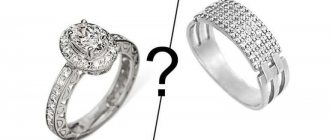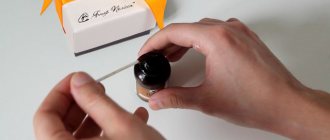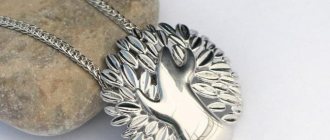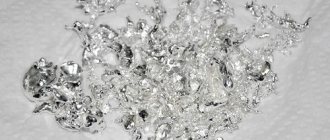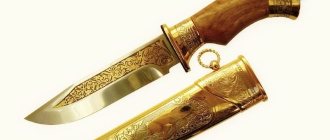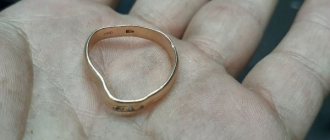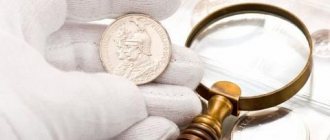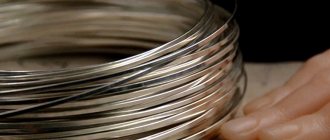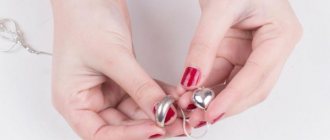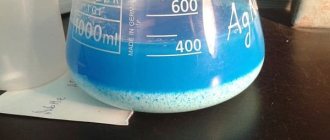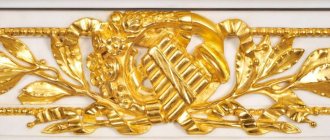Hello!
Jewelry that has lost its former attractiveness does not have to be hidden in a box until better times, because you can restore the metal yourself and visually increase its value without going to a jewelry workshop.
If your missus has been sighing for a long time over her favorite earrings, which have become dull with time, now is the time to please her. Although numerous videos on how to gild silver at home can instill fear, in fact, getting a beautiful product without large material and time costs is very simple.
What is gold plating and why is it applied?
Gilding is a coating of high-grade gold that is applied to the surface of a selected item at home or by a professional jeweler in a workshop. The item being processed can be made of any metal, but in most cases silver is used for this.
Gilding is done:
- to give a golden hue and emphasize the individuality of the product;
- updating the appearance of items;
- durability of a metal item.
How the process works
Before gilding silver items at home, it is important to ensure your own safety, for which this is perfect:
- rubber shoes;
- gloves;
- glasses for eye protection;
- apron.
Regardless of the method used, restoring silver at home always consists of the following steps:
- metal surface preparation;
- spraying or other coating;
- final processing.
Gilding metal is not enough. I recommend creating a protective layer on gold-plated silver. Nitrocellulose varnish is suitable for this.
What metal products can be coated with gold plating?
The most common process is gilding silver, but gold plating can be applied to the surface of other metals. Thus, gilding can be applied to products made of copper, brass and zinc, as well as iron and steel, etc.
There is no clear answer to the question of how to gild metal at home. It all depends on what metal products need to be subjected to such processing. The choice of gilding technology carried out at home is also influenced by the result that needs to be achieved.
With the help of gilding you can give ordinary things a completely different look.
Various methods can be used to gild metal, the most common of which are:
- rubbing the surface of the product with a solution of gold chloride;
- gilding, performed by immersing the product in a solution with a zinc contact;
- galvanic gilding.
Each of these methods of gilding, performed at home, requires the use of certain chemicals, tools and equipment.
Pros and cons of gilding silver
Restoring silver at home will allow you to obtain an aesthetically attractive product without large material costs.
Advantages of using this technology:
- the opportunity to experiment with the appearance of jewelry. If desired, you can order additional engraving or a complex design from the jeweler, which is difficult to reproduce at home;
- silver objects are lighter than gold. Weight is important for both jewelry and cutlery. For example, a gilded silver pendant with stones will please its owner much longer than a gold one due to its light weight;
- affordable price. Silver is much cheaper than gold, and with high-quality work, gold-plated metal at home does not differ visually from gold;
- damaged coating, if necessary, can be easily restored at home. It is less expensive than purchasing a new item;
- variability of coating colors;
- When properly used, gilded silver is durable;
- Gold-plated silver is thicker and has better thermal conductivity, which is why it is used in elements for mechanical watches.
Before gilding silver at home, you should familiarize yourself with the disadvantages of such a procedure:
- Gold-plated items are difficult to care for. It is necessary to constantly ensure that jewelry comes into contact with skin and liquids less often. Dishes with such a coating are contraindicated to be washed in a dishwasher or with the use of chemicals. There are special solutions for cleaning gold plated utensils at home;
- high-grade gold, which is used for gilding, is very shiny, so it is unlikely that it will be possible to hide the true material from the experienced eyes of jewelry lovers and specialists;
- gilding does not prevent the oxidation of the metal, so spots may appear on the treated silver, especially if the operating conditions are not met.
History of the use of silver in various fields
In Rus', too, the healing and neutralizing power of silver objects was noticed quite a long time ago. So, in churches, holy water was poured and stored in silver vessels specially cast for this purpose. And the phenomenon associated with a silver spoon in a glass of water has been known to everyone since the days of studying at school from a life safety course.
It is thanks to its unique properties that silver began to appear in a huge number of objects surrounding humans. Ancient and modern scientists, inventors and jewelry makers try to cleanse the world around a person who owns one or another silver item. Gradually, silver could be found in almost all cutlery, dishes, mirrors, and, of course, jewelry. Elements of silver were added to fabrics, which made it possible to decorate even clothes and shoes.
Today, silver can be found in a variety of medical devices; it is used in the food industry (for example, silver is part of some food additives with indicator E), in the laboratory industry (for the manufacture of various vessels for melting alkalis or other metals). In electrical engineering, it is also impossible to do without silver, which is part of copper conductors and various waveguides. Among other things, in some chemical reactions it is impossible to do without silver molecules. This metal (more precisely, silver nitrate) is also used to create photographs.
How long does it last
The durability of the coating is affected by how carefully the silver is stored and worn. If an item is purchased in a jewelry store and has quality certificates, it will delight the owner for more than 2 years. Earrings and brooches that have little contact with the body will retain their visual appeal longer than a chain or bracelet.
Factors that negatively affect the durability of gold-plated items:
- contact with water and chloride compounds contained in it;
- exposure to concentrated chemicals;
- improper care;
- constant friction against the skin, interaction with sweat.
Application of zinc contact
To obtain a thicker gold-plated layer, a zinc contact is used. Using this method, you can, for example, coat silver with a layer of gold. For gilding, a composition is prepared from the following components:
- gold chloride – 15 grams;
- carbonic potassium salt – 65 grams;
- yellow blood salt – 65 grams;
- table salt – 65 grams;
- water – 2 l.
It will take some time to dissolve all components of the composition
Products made of copper and brass are plated with gold in a solution of the following composition:
- gold chloride – 2 grams;
- caustic potassium – 6 grams;
- potassium cyanide – 32 grams;
- sodium phosphorus salt – 10 grams;
- water – 2 l.
Objects on the surface of which it is necessary to apply a layer of gilding are thoroughly cleaned of dirt and grease, then they are placed in a preheated gilding composition. The products already there are connected to a zinc rod, which acts as a contact.
Compositions of degreasing solutions
In order for the gilding applied to the surface of products made of steel, zinc and tin to be of high quality and have good adhesion, they must be subjected to a copper plating procedure before gilding.
Methods of gilding silver
The quality of the resulting coating depends on the chosen technique for creating gilding at home.
The most popular methods:
- chemical method;
- mechanical;
- electroplating
All of these options are suitable for doing at home and involve the use of a reaction of special chemical compounds.
Chemical method
This option of gilding involves applying gold chloride to silver or other material at home.
Stages:
- prepare aqua regia (a compound of concentrated acids);
- dissolve the gold product, divided into small fragments, in the resulting substance;
- evaporate the water until a dry residue is obtained;
- mix the resulting substance with calcium carbonate and a solution of potassium cyanide until a paste-like consistency is obtained;
- apply the mixture to the silver with a brush;
- After drying, rinse the item under running water and polish.
Mechanical method
This method is used very rarely, since achieving uniformity of the surface layer at home is not easy.
Features of mechanical gilding:
- To obtain the desired result, a special rubbing paste is used. The composition is prepared in a specialized store or at home;
- The mechanically applied coating has a very thin layer. It will not retain its attractive appearance for a long time, even if the item is gilded in compliance with all the rules and conditions;
- The composition of paste for gilding most often includes cream of tartar, crushed chalk and yellow blood salt. They are mixed with water until a homogeneous mass is obtained and rubbed into the surface of the object using a piece of natural wool;
- before gilding an item at home, it must be degreased with a special solution;
- The paste is applied to the product in an even layer. When rubbing, it is important to ensure that it does not get on exposed skin.
Due to the complexity of execution, the mechanical method is most often used if only a small area of silver needs to be gilded. Other technologies involve completely immersing the object in the solution.
Galvanic method
Electroplating allows you to gild metal and create a durable coating. By changing the proportions of the constituent substances, even at home you can get gilding of different shades.
Procedure:
- clean, degrease and polish the silver product;
- prepare electrolytes based on water, sodium phosphate, potassium cyanide, gold chloride and sodium sulfide;
- heat the solution to a temperature of 60 °C and lower the object into it;
- install anode.
Gilding silver in this way at home takes an average of 14 hours. Upon completion of all stages, the item should be dried on sawdust and polished.
Types of electroplated gold plating
Today, the main methods of gilding are gilding with sodium, ether solution, and contact with zinc. But the most effective is the galvanic method. It is most suitable for decorating jewelry. To apply gold particles to the surface of silver, it is dipped into an aqueous solution of salts and subjected to electric current. The product to be coated is the cathode, and the anode is gold particles.
If silver jewelry is subject to chemical changes (oxidized), then gold-plated products are protected from them. The gilding process is something like this:
- Electrolyte is poured into small containers.
- Gold is dissolved in it.
- The jewelry is immersed in this solution and left for some time.
- Oxides begin to settle in a thin layer on the products.
- Take out the jewelry, wait for it to dry, polish it or cover it with a protective layer.
In industry, electroplating is used to produce a product with a layer of gold. The gold plating can be pink, imitating 585-carat metal. Such products are almost impossible to distinguish from gold ones. There is also a yellow galvanized coating. It contains not only gold, but also nickel. This yellow color resembles pure gold.
Preparing a composition for gilding at home
You can prepare the solution for gilding yourself.
To do this, mix:
- water (1500 ml);
- gold chloride (10 g);
- potassium cyanide (30 g);
- salt (20 g);
- soda (20 g).
To obtain a thinner layer of gold plating you will need:
- water (2 l);
- gold chloride (15 g);
- yellow blood salt (65 g);
- carbonic potassium salt (65 g);
- table salt (65 g).
All components must be well dissolved, otherwise the gilding layer will be uneven, and even thorough polishing will not help. When the product is immersed in liquid, it is necessary to lower a zinc stick into the container (zinc contact method).
Preparation and use of gold chloride
To gold-plate metal, a solution called gold chloride is often used. To prepare such a solution, gold is dissolved in “aqua regia,” which is a mixture of hydrochloric and nitric acids. Hydrochloric and nitric acids are taken in a ratio of 3: 1. Gold is placed in this composition, and then the liquid is evaporated. The procedure for evaporating liquid from such a solution should be carried out very carefully so as not to cause burns to the skin and respiratory tract. The dry substance remaining after evaporation is precisely gold chloride.
When evaporating, you need to separate the open fire from the container with the solution, for example, by making a layer of asbestos chips poured into a separate container
Before using gold chloride for gilding, it must be mixed with a solution of potassium cyanide and washed chalk, resulting in a paste-like mass. Using a brush, this paste is used to cover the product, after which it is left for some time, and then thoroughly washed and polished.
To gild steel, gold chloride is mixed with ether. The product coated with this composition is left for some time until the ether has completely evaporated, and then the treated surface is simply rubbed with a cloth to impart a golden shine.
Using gold chloride, previously mixed with ether, various inscriptions and patterns can be applied to a metal object. In order to carry out this procedure, a quill pen is dipped into the resulting solution and the required inscriptions and patterns are made, which, after evaporation of the ether and polishing, will sparkle with a golden sheen.
Large surfaces are covered with gold using a soft brush
As mentioned above, gold plating is often applied to silver, for which gold chloride can also be used. To perform chemical gilding of products made from this metal, it is necessary to prepare a mixture that includes the following components:
- gold chloride – 10 grams;
- potassium cyanide – 30 grams;
- table salt – 20 grams;
- soda – 20 grams;
- water – 1.5 l.
Chemical gilding, which must be applied to silver, can also be performed using a mixture of:
- gold chloride – 7 grams;
- potassium ferric sulfide – 30 grams;
- potassium carbonate – 30 grams;
- table salt – 30 grams;
- water – 1 l.
The procedure for sputtering a layer of gold onto a metal surface using chemical solutions is performed in the following sequence.
- The product being processed is pre-calcined.
- The surface of the object is etched first with a solution of sulfuric acid and then with nitric acid.
- The pickled product is momentarily dipped into a mixture consisting of sulfuric, nitric and hydrochloric acids.
- After treatment in a mixture of acids, the product is rinsed with water, then immersed in mercury and finally in water, where it is kept for 30 seconds.
- After a container of water, the product is placed in a solution for gilding, kept for the required time, then washed with water and dried in sawdust.
Rules for using gold-plated products
The durability of gold-plated items depends on their proper use and storage conditions.
Recommendations for use, following which you can enjoy the beauty of gold-plated products for many years:
- Are you going to take a bath or shower? Be sure to remove earrings and other gold-plated jewelry. It is important to prevent them from coming into contact with soapy water;
- store items in closed boxes, caskets, avoiding exposure to sunlight and moisture. To prevent jewelry from being scratched, you need to place each item in a soft fabric bag or place it in separate chests;
- gilding a product with a thick layer of metal is not enough; it is important to clean it properly;
- Do not store gold-plated jewelry in the kitchen, bathroom or other rooms in high humidity conditions.
Cleaning
To clean a gold-plated item at home without damaging the coating, you will need:
- suede cloth;
- vinegar;
- ethanol.
Suede is useful for polishing silver. It is used immediately after cleaning to give things shine. If a piece of jewelry that has been successfully gilded is worn every day, you should wipe it with a cloth every evening before placing it in the box.
Small stains can be removed with ethyl alcohol. Silver is treated with a cotton pad soaked in the substance. An aqueous solution of vinegar will help remove significant stains; just place a silver item in it for a quarter of an hour.
Under no circumstances do I recommend immersing silver in a soap or soda solution: in such conditions, the decorative coating will be irrevocably damaged.
Purchasing Tips
You can purchase high-quality gold-plated jewelry in jewelry stores, but you need to know some selection rules so as not to be mistaken in the value of the product.
Silver products must have a stamp confirming the hallmark . If it is not there, then it is not a precious metal, but a jewelry alloy coated with gold. Such products are often purchased because they are cheaper, but they quickly deform.
Different types of silver can be used to make jewelry, but experts recommend choosing 925 silver. Products made from it are of much higher quality, so they will last a long time. The percentage of gold plating should be more than 40%.
How to identify gold-plated silver
Visually, gilded silver does not differ from gold, and therefore it is difficult for an ordinary buyer in a store to distinguish between real gold and gilding. The original accessory is indicated by the presence of a stamp. By looking at the sample, you can immediately discern what metal the jewelry is made of. Even if an additional coating is used on a silver accessory, the silver standard will always be on it, because this is the main metal. Often the standard on silver jewelry is 875 or 925. On gold jewelry you can see a stamp with the following numbers: 585, 375, 750.
Please note that jewelry purchased abroad has different markings. Most often you can see the following samples:
- KGP;
- HGE;
- Golgmult.
It will not be possible to examine the sample with the naked eye; this will require a magnifying glass. You should not buy jewelry from dubious workshops; scammers often solder a stamp with a counterfeit mark and the average person cannot notice it. You need to purchase jewelry only in stores with a good reputation and where there are the necessary certificates indicating quality products.
One of the disadvantages of such jewelry is the high risk of encountering a fake. Therefore, you need to purchase products only from trusted places.
Is it possible to restore gilding on silver?
If your earrings, bracelet or ring are frayed and some areas of the gilding have peeled off, they can be restored to their beautiful appearance. To do this, you need to reapply the gold plating and contact a workshop. You need to contact an experienced specialist to ensure that the product lasts at least a year. Keep in mind that not every jeweler has professional equipment for gilding. Sometimes the cost of plating jewelry with gold is higher than the price of finished silver jewelry.
Before applying gilding to the jewelry again, you need to calculate whether it will be profitable and get acquainted with the prices in several workshops.
How to maintain color and shine?
Simple tips will help preserve the color and shine of jewelry; it is recommended to remove jewelry before:
- taking a bath or shower;
- sports training;
- cleaning, washing.
Jewelry should be protected from moisture, so remove it before going to the bathroom or shower. Soap solution can negatively affect the condition of the gilding and damage the coating.
Gold plating is susceptible to friction; over the years, the coating may become thinner, so you should not wear items made of gold-plated silver during active sports.
Aggressive reagents act on the coating, damaging it. As a result, dark spots appear on the jewelry, which will be difficult to get rid of.
Proper care will help preserve the color and shine of the product; for this you will need:
- Suede leather.
- Ethanol.
- Vinegar.
Suede is used to polish jewelry; this can be done immediately after cleaning or instead of it.
In any case, the silver layer cannot be damaged, but the gold plating may wear out when in contact with aggressive agents, so jewelry should not be immersed in solutions with soap, salt and soda.
Candy bowl made of silver with gilding of individual parts
You can wipe the product with alcohol, first apply it to a cotton pad or lint-free cloth.
Dip jewelry into a solution of vinegar and water for no more than 20 minutes if the contamination is severe. If routine cleaning is required, you can simply wipe the metal surface with a cloth soaked in a vinegar solution.
Alcohol adds shine, but the products can also be placed in beer, for which one glass of this drink is enough. Decorations are immersed in beer for 15–20 minutes, no more.
Method for cleaning gold plating
Before you begin cleaning gold-plated jewelry, you need to properly prepare it for the procedure. To do this, gilded objects are carefully wiped with a dry rag - wool, suede, or felt are suitable. To clean off fat deposits, you need to additionally use turpentine or an alcohol solution - a small amount of the chosen product is applied to a soft material or cotton pad and wiped over the jewelry. For final cleaning, alcohol will be enough, but you can use traditional methods:
- To add shine and remove any plaque, it is recommended to immerse the jewelry in beer for 15-20 minutes and wipe dry. To clean a classic set with this method, 1 glass of drink will be enough.
- If you rub the gold plating on your jewelry with egg white, the shine will return. To perform the manipulation, you need to separate the protein, moisten a rag or sponge and carefully rub the entire surface. The remains will cover the material with a protective film.
- Beaten egg yolk with 1 tbsp. sorrel decoction will restore the shine of the jewel. After treating with this composition, you need to rinse the jewelry in water and rub it with a rag.
- By using wine alcohol, darkened areas on the coating are eliminated and all types of contaminants are removed. To clean, soak a sponge or rag in the product and rub the surface.
Attention! You can use vinegar for items coated with a thin layer of gold, but complete immersion in a 9% solution is acceptable for up to 20 minutes for heavily soiled items. When the duration of the procedure is disrupted, the gilding may wear off. If you plan to do simple cleaning, you can simply wipe it with a sponge or rag.
Jewelry metals lose their shine and brightness of color over time, and the film of gold-plated products is no exception. In order for the coating to be removed from the product, it must be mechanically damaged. If the care meets the standard, then it is impossible to determine by its appearance that the item is classified as silver. When a noticeable stain appears on the jewelry after a short period of use - the gilding in this place has worn off, it is better to return it to the store or take it to a jeweler to check the alloy.
Recoating
If you still decide not to part with your jewelry and leave it with gold plating, you can turn to specialists for help. Using a special device, a new coating is applied in a matter of minutes. How much does it cost to apply the coating? The cost of gilding is considerable; gilding one ring will cost about 350 rubles, and chains - from 2000 rubles. The price depends on the grade of gold used and the thickness of the applied coating.
As you can see, high quality gold-plated silver should cost significantly more. Re-gilding has other advantages. You can apply gold in a different shade, such as white, red or pink. When electroplated, the gold layer has high adhesion to the surface being treated. After repeated restoration, the product will look completely new.
To restore the coating, you need to choose only a professional master. The work must be done very efficiently, with knowledge of all the nuances and technological details.
Gilded silver looks beautiful and, when handled with care, pleases the eye for a long time. It is not intended for everyday wear, so if your favorite item no longer looks neat, it is better to remove or restore such coating.
Electroplating gilding of silver jewelry
In order to give the jewelry the proper appearance, and also to ensure that it can serve you for a long time, jewelry craftsmen resort to various tricks. One such option is electroplating a silver product with gold. This combination of metals occurs quite often; as a rule, a more expensive material is used as a coating. Metal, which has a relatively low price, on the contrary, is coated. In this version, the coating film is very thin, but this does not prevent it from performing its functions to the maximum.
At the same time, this allows you to significantly reduce the price of the finished gold-plated product.
Electroplating is one of the newest options and methods for processing silver and gold jewelry. You can resort to this option of gilding only with the help of special devices. Firstly, an electrolytic solution is used for this. It allows, using a passing electric charge, to split the material immersed in a solution into tiny particles. As a result of electrical action on them, gold molecules tend to the silver product, thereby enveloping it.
You can resort to electroplating even before the product is completely completed, but most often professionals advise exposing finished jewelry to this kind of influence. The price of the resulting product is practically no different from the same one, but completely silver, and the appearance, on the contrary, completely copies exactly the same, but gold jewelry. In any jewelry workshop you can find a craftsman who can coat your (perhaps an old ring or bracelet) with a layer of gold using this principle. The price of this procedure varies from 100 to 500 rubles, depending on the area of your product (a massive chain of gold will require more than a small ring).
Thus, by purchasing a “gold” ring at a much lower price, you both save money and make a very reliable investment of your savings in precious metals. This approach also allows you to avoid counterfeits, because it is impossible to purchase real gold jewelry for the same money, and in many parts of any city you can find people willing to sell similar goods (passed off as gold) at a very low price. And few potential buyers think about the fact that free cheese is only in a mousetrap.
Choosing the right gold plated jewelry
So, what do you need to know about choosing gold plated products? The material that is sprayed is of primary importance in this matter. It is important that it is 925 silver. This fact speaks volumes about the value of the product. Sometimes spraying can be applied to aluminum, copper, and tin. Such works are valued even cheaper than silver ones.
How can you determine what kind of jewelry you have in front of you: made of gilded silver or another metal? First, examine the product from all sides, find the brand and markings. To do this, familiarize yourself with silver hallmarks and hallmark standards in advance. In the Russian Federation, the following standards are established for silver: 999, 960, 925, 875, 830, 800. Most often, 925 silver is used for gilding. Since Soviet times, a mark in the form of a barrel has been used on silver jewelry.
Sources
- https://zolotoe-runo-sl.ru/dragocennye-kamni/pozolota-na-serebre.html
- https://zhazhdazolota.ru/serebro/kak-pozolotit-serebro-v-domashnikh-usloviyakh
- https://FB.ru/article/408985/pozolochennoe-serebro-otzyivyi-printsip-naneseniya-stoykost-pozolotyi-osobennosti-uhoda-rekomendatsii-i-otzyivyi-yuvelirov
- https://met-all.org/obrabotka/prochie/zolochenie-domashnih-usloviyah-pozolota-galvanicheskoe.html
- https://vplate.ru/serebro/pozolochennoe/
- https://hozsekretiki.ru/garderob/aksessuary/pozolochennoe-serebro-stiraetsya-ili-net.html
- https://vplate.ru/serebro/zolochenie/
- https://DedPodaril.com/serebro/vidy/pozolochennoe-serebro-stiraetsya-ili-net.html
- https://HochuZoloto.com/prochee/skolko-derzhitsya-pozolota-na-serebre.html
Electroplating
There are two ways:
- Three solutions are prepared: 60 g of sodium phosphate with 700 g of water; 2.5 g of gold chloride and 150 g of water; 1 g potassium cyanide and 10 g sodium sulfate with 150 g water. The first two solutions are mixed, the third is added last. Temperature - 50-60 degrees. The anode is made of platinum. When the electrolyte solution is depleted, gold chloride is added.
- Bath according to Zelmi: mix 1 g of potassium hexacyanoferrate (yellow) and sodium carbonate with 30 g of water, heat in a porcelain cup. Add gold precipitated with ammonia to the mixture. Boil for 10-12 minutes. When water evaporates, it is added and a Daniel element current is passed through the solution. Exposure time is 15-16 hours.
Gilding methods at home are labor-intensive and not always available. The preferred method is chemical gilding or rubbing.
Source: dedpodaril.com
We prepare gilding solutions ourselves
To gild any object, you need a solution, or rather, dissolved gold. To obtain it, you need to dissolve gold in the so-called “aqua regia” - a mixture of hydrochloric and nitric acids. They must be taken in a ratio of 3:1. After the gold has dissolved, the liquid must be evaporated. This must be done very carefully, because you can get burns to your hands, face or respiratory tract. What's left is chlorine gold. It must be dissolved with a solution of potassium cyanide, and then mixed with washed chalk. You need enough of the latter to get a paste of liquid consistency. Taking a brush, you need to cover the object that you want to gild with the resulting slurry, and after a while it needs to be washed and polished.
To gild steel and iron, a solution of gold chloride is often used, which is mixed with ether. It evaporates, and the gold-plated surface must be rubbed with a cloth. You can make a gold pattern. To do this, take a quill feather, soak it in gold and draw the desired pattern or line.
